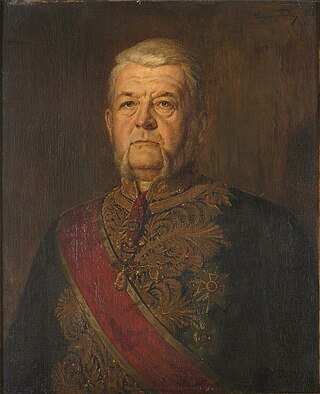
Mayr-Melnhof Karton AG is a manufacturer in the paper and packaging industry, based in Vienna, Austria. The company is 65% family owned, with the rest free-float, and is listed on the Vienna Stock Exchange.
Count Jefferson von Pfeil und Klein-Ellguth is a German nobleman and a banker.

Princess Sunnyi of Sayn-Wittgenstein-Sayn is a Swiss-Hungarian actress active in Germany and Austria.

Adolf Wilhelm Carl Daniel, Hereditary Prince of Auersperg was a Bohemian and an Austrian nobleman and statesman. He served as eighth prime minister of the western part of the Austro-Hungarian Empire (Cisleithania) and ninth provincial president of Salzburg.

Konrad Maria Eusebius Prinz zu Hohenlohe-Waldenburg-Schillingsfürst was an Austrian aristocrat and statesman. He briefly served as Prime Minister of Austria (Cisleithania) in Austria-Hungary in 1906.
Graf August David of Sayn-Wittgenstein-Hohenstein was a Prussian politician. He was a member of the Cabinet of Three Counts, with Johann Kasimir Kolbe von Wartenberg and Alexander Hermann, Count of Wartensleben, also known due to their heavy taxation as "the great W(oes)" of Prussia. As a favorite of Johann Kasimir Kolbe von Wartenberg, he was later imprisoned at Spandau Citadel, fined 70,000 thalers and banished subsequently by Frederick William due to corruption, wastage and inefficiency.

Alexander Konrad Friedrich Heinrich Prince zu Sayn-Wittgenstein-Sayn, is a German businessman, who is head of the Princely House Sayn-Wittgenstein-Sayn.

Princess Anna of Bavaria, known professionally as Anna von Bayern, is a German journalist and author who has been serving as the Chief Corporate Affairs Officer at Coty Inc. since 2020. A member of the House of Sayn-Wittgenstein-Berleburg by birth, she became a member of the House of Wittelsbach in 2005 through her marriage to Prince Manuel of Bavaria.

Franz Erwein, 1st Count of Schönborn-Wiesentheid was a German art collector and politician from the House of Schönborn.

Arthur Franz Maximilian, 4th Count of Schönborn-Wiesentheid was an Austrian nobleman.
Klemens August Emmerich, 3rd Count of Schönborn-Wiesentheid was an Austrian Reichsrat and Member of the Reichstag of the German Empire.

Clemens August, Freiherr von Westphalen zu Fürstenberg was a German aristocrat who held numerous offices in various North-West German Bishoprics and served as Minister of State of the Electorate of Mainz and Imperial Envoy.

Count Rudolf Franz Erwein von Schönborn, was a German politician and diplomat who was also active as a composer and a Knight of the Order of the Golden Fleece.
Anselm Franz, Graf von Schönborn-Heusenstamm was a German landowner and aristocrat.

Hugo Damian Friedrich Karl Franz Erwein von Schönborn-Wiesentheid, was a German chamberlain and member of the counsel from Aschaffenburg. He was Count of Wiesentheid from 1772 to 1806. After the dissolution of the county he withdrew to his estates in Vienna.

Franz Philipp Joseph, Graf von Schönborn-Buchheim, was an Imperial and Royal Lieutenant Colonel, Imperial and Royal Chamberlain.

Karl Eugen Damian Erwein, Fürst von der Leyen und zu Hohengeroldseck was a Baden nobleman, Bavarian landowner and Major General.
Friedrich Karl Joseph von Schönborn was a German aristocrat and composer.
Erwein Friedrich Karl, Graf von Schönborn-Buchheim was an Austrian landowner and aristocrat.
Alfred Konstantin Chlodwig Peter Maria Prinz zu Hohenlohe-Waldenburg-Schillingsfürst was an Austrian aristocrat and diplomat.















